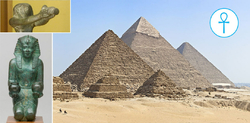- Retour accueil
- Vous êtes ici : Blog The Pyramids of the Cold The Pyramids of the Cold Section 32 • Anubis and the bobsled mask
The Pyramids of the Cold Section 32 • Anubis and the bobsled mask
Publié par Bruno Coursol dans The Pyramids of the Cold le 20/03/2023 à 13:36
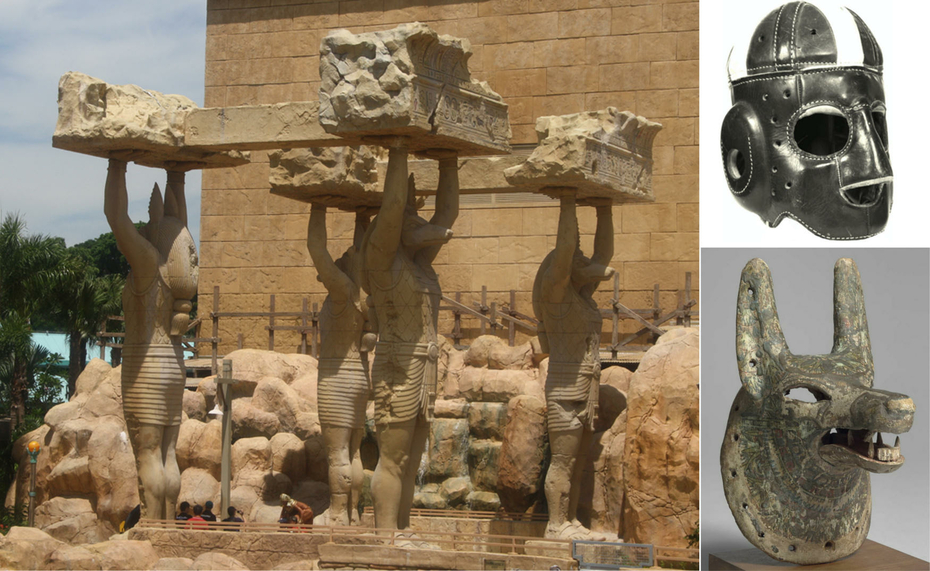
The Pyramids of the Cold Section 32 • Anubis and the bobsled mask
In summary: the deciphering of the operation of the Grand Gallery of the Great Pyramid continues with Anubis and Wepwawet, the two jackal-wolf gods. Just like we've already seen with so many ancient Egyptian deities, both Anubis and Wepwawet are two different glorifications of the same thing: the sledge that put the impactor into motion.
When Anubis represents the sledge descending the Gallery at full speed, giving all his power to Osiris, and in some ways lifting him above the floor, Wepwawet represents the same sledge, but getting back up to the top of the Gallery during the sequential Hauling part of its operating cycle.
The action of the sledge could be seen both as a sliding and a lifting movement, but if ancient Egyptians referred to both of these aspects; it is the latter one which has produced one of the most spectacular staged scene of all ancient Egypt: the famous four lifting giant statue replicas of Anubis with their arms above the head at Universal Studios, Singapore.
The whole point of the Great Pyramid being to create cold, it is then not surprising that many things about the operation of the sledge has been directly associated with that cold; and among those, the masks of Anubis which were simply bobsled masks.
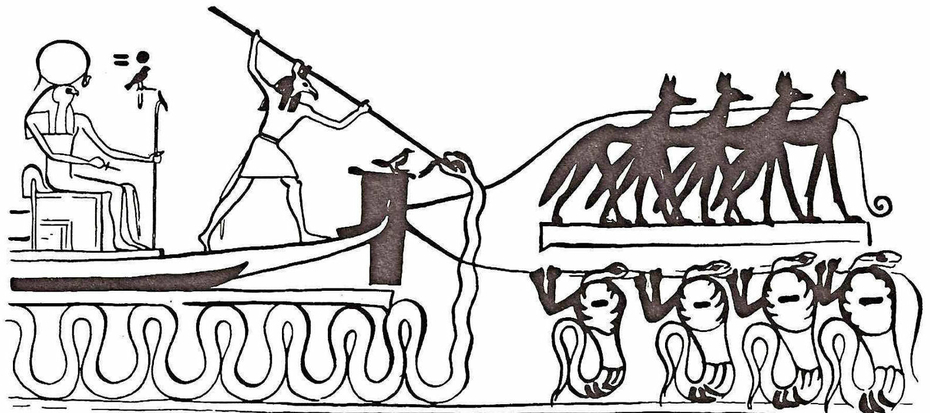
32.01 The jackals are all about putting the "solar boat" into motion
In previous Section 31, I've corrected the error I've made about the 8 crewmembers hypothesis for the operation of the Hauling beetle; and it mostly is the above image that tricked me about it. There are indeed 8 characters who are really looking like they are hauling the solar boat, in two rows of four, just like the design of the Beetle, one row on reach ramp of the Grand Gallery.
But when I think it through now, it actually makes no sense to associate the boat with the hauling process, because Seth "attacking" the Great Serpent Apep is clearly saying that the scene is about the ramming of the impactor into the inclined well waters (Seth is pressurized air, Section 27); and there was no hauling involved in this part of the Grand Gallery's operating cycle.
So, if "no one" is hauling the boat in this picture, because the "boat" is already speeding towards the well, the only possible explanation is one more time about another metaphor: the four jackals and the four snakes are not hauling back up the impactor to the top of the Gallery, but they are the ones giving all his speed and all his energy to the impactor.
We've already seen that the snakes are mostly metaphoric representations of the water used to power up the Pyramid, and they probably are also about water here; but the big question is about the jackals: they are the key, why are there four of them, and why is there a snake (most probably water) for every one of them?
The jackals are the key that explain the movement of the "solar boat", and will see in this Section that the jackals are about the sledge and its runners.
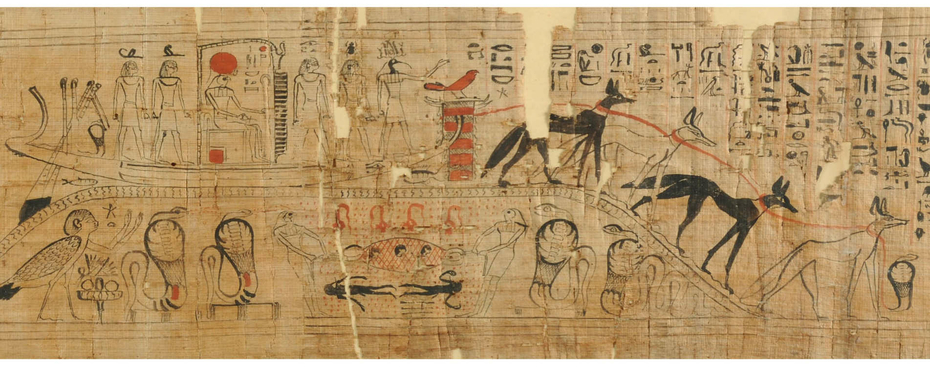
"Funerary papyrus of Djehutymes", at the Museo Egizio, Torino, Italia: https://collezioni.museoegizio.it/en-GB/material/Cat_1781
32.02 The descending jackals leading the solar boat of Ra are about the sledge of the descending impactor
In the above image, we see that the solar boat is like at the top of what looks like kind of a hill: the boat has been brought to the top of the hill and is now ready to get down that hill. We also see that it is the jackals who are the ones leading the way, or "opening the way".
This is why both Anubis and Wepwawet, the most famous ancient Egyptian jackal-headed gods were called " the openers of the ways".
We'll see in this Section, that the jackals are deifications of the sledges used in the Grand Gallery (as well as the glorification of all the other sledges which were used in the past, before the Great Pyramid)
We'll see that Anubis is just one of these glorification of the sledges, and that he is precisely about the sledge of the impactor during its descent towards the well (moving towards the north).
But first, we need to focus ourselves on Wepwawet, the god who was the deification of the sledge of the impactor, but only in its ascending part of the cycle (moving towards the south).
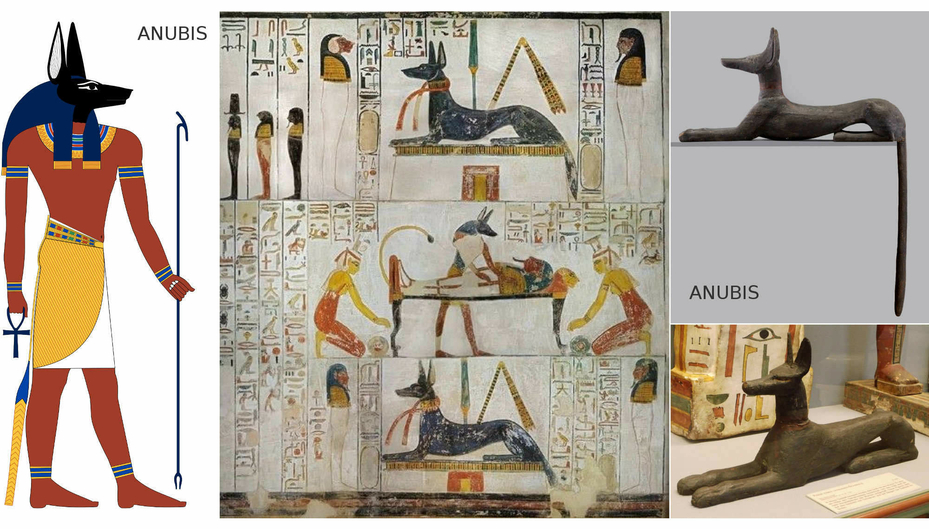
"the jackal headed god of ancient Egypt. Based on New Kingdom tomb paintings", by Jeff Dahl: https://en.wikipedia.org/wiki/Anubis#/media/File:Anubis_standing.svg
Image in the center: "Litany of Re with Scenes of Anubis. Besides the litanies of Re, we find the vignette of Chapter 151 of the Book of the Dead. It represents the mummification of the dead king under the protection of Anubis, Isis, Nephthys and the four sons of Horus". New Kingdom, 19th Dynasty, ca. 1292-1189 BC. Detail on the ceiling in the Tomb of Siptah (KV47), Valley of the Kings, West Thebes. The Egyptian Museum in Cairo: https://egypt-museum.com/litany-of-re-with-scenes-of-anubis/
Image on the right, up: "Wooden statue of Anubis at the MET, "This sleek wooden statue of the jackal god Anubis wearing a red ribbon around his neck depicts him guarding the necropolis, one of his commonest roles. The Egyptians knew that jackals inhabited the desert edge, where cemeteries were located. The pose Anubis takes here represents the god perched on his sacred mountain above the necropolis, with his tail drooping downward. This is the same form of Anubis addressed in the standard funerary prayer that Egyptian priests recited for the deceased." https://www.brooklynmuseum.org/opencollection/objects/4155
Image on the right, down: "Wolf - Anubis (Kunsthist. Museum Wien)". Photograph: Ralph Haussler: https://ralphhaussler.weebly.com/wolf-mythologie-egypt.html
32.03 Anubis and Wepwawet: the most famous jackal-headed ancient Egyptian gods
Most of the time, Anubis and Wepwawet are not really described as "brothers" (I've only seen one author, for whom Anubis and Wepwawet are even called "twin brothers"); and we also know that even the fact of trying to see gods as part of a traditional family tree really is worthless.
But obviously, in their jackal-headed human forms, Anubis and Wepwawet really are "twin brothers", in some way, and they only differ by the color of their faces: Anubis is represented with a black jackal-head face, when Wepwawet is represented with a white or grey jackal-head face.
Even if Anubis is the most famous of them, it is with Wepwawet that we can understand them both.
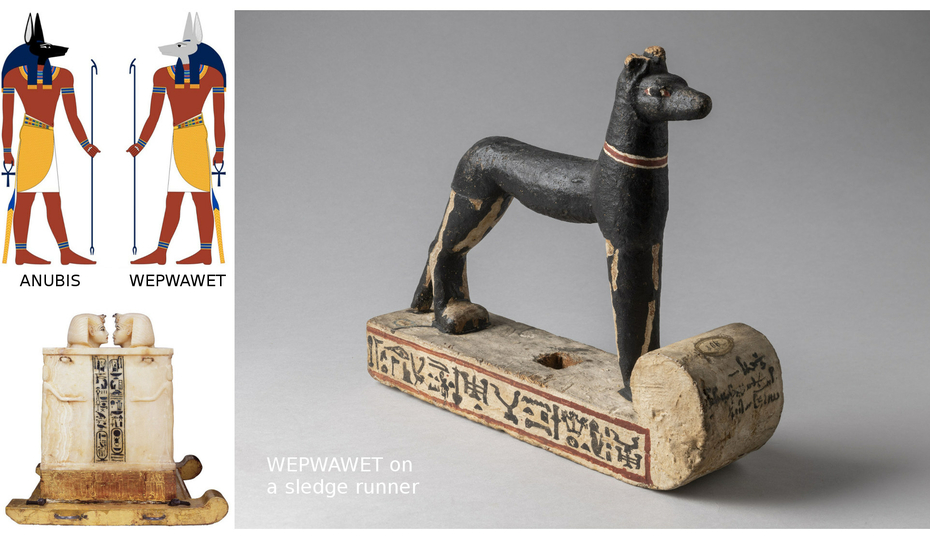
Draw of Wapwewet by Jeff Dahl: https://en.wikipedia.org/wiki/Wepwawet#/media/File:Wepwawet_standing.svg
The Canopic Chest of Tutankhamun: http://www.globalegyptianmuseum.org/detail.aspx?id=15099
Wooden representation of Wepwawet, "Banner with image of the god Upuaut [Wepwawet]", at the Museo Egizio, Torino: https://collezioni.museoegizio.it/it-IT/material/Cat_914
32.04 Wepwawet was moving South and identified as both Horus and Ra
The major deciphering key of this Section is the above wooden representation of Wepwawet, that is today at the Museo Egizio in Torino, Italy. The artifact actually couldn't be more explicit about what really represents Wepwawet, and that is obviously all about a sledge runner.
I first thought that Wepwawet was precisely that, all about the runners of a sledge, and that consequently Anubis would be about the sledge itself, but I was wrong; I couldn't make it work with what we know of Wepwawet:
• Wepwawet is called "Ra" who has gone up from the horizon
• Wepwawet was sometimes called the “son of Isis” and identified as Horus
• Wepwawet [is] the opener of the roads to the South
What these 3 elements have in common, is that they are perfectly describing the impactor itself ("Ra" and "Horus"), ascending the Grand Gallery from the darkness of the well ("going up from the horizon") and moving towards the south side of the Gallery.
It means that Wepwawet is the sledge of the ascending impactor Ra/Horus.
Through Wepwawet, these excerpts "Wepwawet is called Ra and is identified as Horus" are also the proof that Ra = Horus
So now, we also have Ra = Horus = Wepwawet
Of course, the equal signs aren't exactly exact so to speak: each and every one of them have their own specificities, but they all are an aspect of the impactor.
"In late Egyptian mythology, Wepwawet (hieroglyphic wp-w3w.t; also rendered Upuaut, Wep-wawet, Wepawet, and Ophois) was originally a war deity, whose cult centre was Asyut in Upper Egypt (Lycopolis in the Greco-Roman period). His name means opener of the ways and he is often depicted as a wolf standing at the prow of a solar-boat. Some interpret that Wepwawet was seen as a scout, going out to clear routes for the army to proceed forward."
"In later Pyramid Texts, Wepwawet is called "Ra" who has gone up from the horizon, perhaps as the "opener" of the sky." https://en.wikipedia.org/wiki/Wepwawet
"According to E.A. Wallis Budge in The Gods of the Egyptians Anubis shared the duty of guiding the dead through the afterlife with another jackal-headed god ... "Opener of the Ways"). These two gods both "opened the ways", although Anubis was the opener of the roads of the North and Wapwawet the opener of the roads to the South. Budge goes on to say that Anubis was the personification of the summer solstice, and Wapwawet of the winter solstice." http://www.touregypt.net/featurestories/anubis.htm
"His relationships with the other gods were confused by the merging and shifting of roles throughout Egyptian history. Wepwawet was closely associated with Anubis who was originally part of the Ogdoad of Hermopolis, and came to be seen as his son. However, he was also linked to the god Shu of the Ennead of Heliopolis by the epithet “he who has separated the sky from the earth”. […] To complicate matters further, Wepwawet was sometimes called the “son of Isis” and identified as Horus." https://ancientegyptonline.co.uk/wepwawet/

32.05 Operating cycle of the Grand Gallery Position P4 Side view
The impactor is now called Horus the child and is hauled back up to the top of the Grand Gallery, using the latch bolts in the walls. The impactor's Hauling rope has become Isis and its sledge runners ascending the Gallery have become Wepwawet.
32.06 The twisted Sun metaphor used to reproduce the endless cycle of the Grand Gallery's operation
We also have here a perfect illustration of the fact that Ra and the Sun are only metaphors: the natural movement of the Sun is East to West; but even though Wepwawet is identified with Ra, he has a totally different orientation of movement by moving towards South. And with Anubis being described as moving towards North, it is a totally different orientation of movement that is appearing.
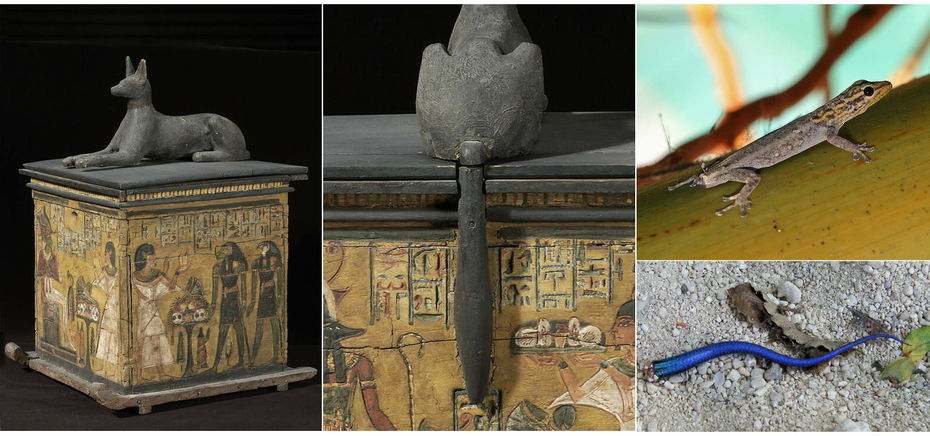
Canopic jars chest N 4094, from the Louvre: https://collections.louvre.fr/en/ark:/53355/cl010008066
"A white-headed dwarf gecko with tail lost due to autotomy.", by Muhammad Mahdi Karim: https://en.wikipedia.org/wiki/Autotomy#/media/File:White-headed_dwarf_gecko.jpg
"A lizard tail shed by autotomy", by Metatron: https://en.wikipedia.org/wiki/Autotomy#/media/File:Lizard_tail_autotomy.JPG
32.07 The lizard metaphor of the severed tail and the release of the impactor (through its sledge)
The huge tail of the full jackal representations of Anubis, really puzzled me until I stumbled on the following excerpts, and realize that it was all about the entire cycle of operation of the impactor, from the sledge point of view:
"Like many Egyptian gods, Anubis was capable of shapeshifting; he was so shocked at the sight of Osiris’s dead body that he immediately turned into a lizard." "Anubis was a faithful follower of Isis, who adopted him following his abandonedment as an infant. A fierce fighter, he routinely defeating the god Set in battle." https://mythopedia.com/topics/anubis
The metaphor about Anubis "turning into a lizard", is about the release of the impactor; if you look closely to the canopic jars chest from the Louvre, you'll notice that Anubis' tail is blocking him from going frontwards; but you'll also notice that the tail is actually designed in two parts: the tail is supposed to "break" and to let Anubis go.
The tail of Anubis, just like the tail of the lizard are designed to be cut off on demand and just like the tail of the lizard will grow back, the tail of Anubis will be reassemble just before another cycle can start again.
That is about the release of the impactor, and what it is also suggesting, even if it is highly questionable, is that the release of the impactor was triggered through Anubis: the release mechanism of the impactor might have been triggered through the sledge itself.
Maybe (very hypothetical), the huge tail is also telling us that the release mechanism was triggered by a large "stick" or "lever" which would have been operated from the top platform by teammate 7 (Matet, previous Section 31).
32.08 The impactor's recovery by the Isis Hauling rope
If I'm saying that the above excerpt is not just only about the release of the impactor; but about the entire cycle of its operation, it is because it is also mentioned the fact that, at some point Anubis gets "abandoned" as an infant, before being "adopted" by Isis: "Anubis was a faithful follower of Isis, who adopted him following his abandonedment as an infant."
We've seen that Isis is the deification of the Hauling rope, so the "adoption" of Anubis by Isis, is actually the "rescue" or "recovery" of the impactor floating in the well, inert and fragile like an infant.
Attention, even if Isis is "adopting" Anubis (the sledge which just rammed into the waters of the well), when Isis is actually hauling the impactor, the sledge isn't called Anubis anymore, but Wepwawet (see the above and below Position P4 views of the operating cycle of the Grand Gallery).
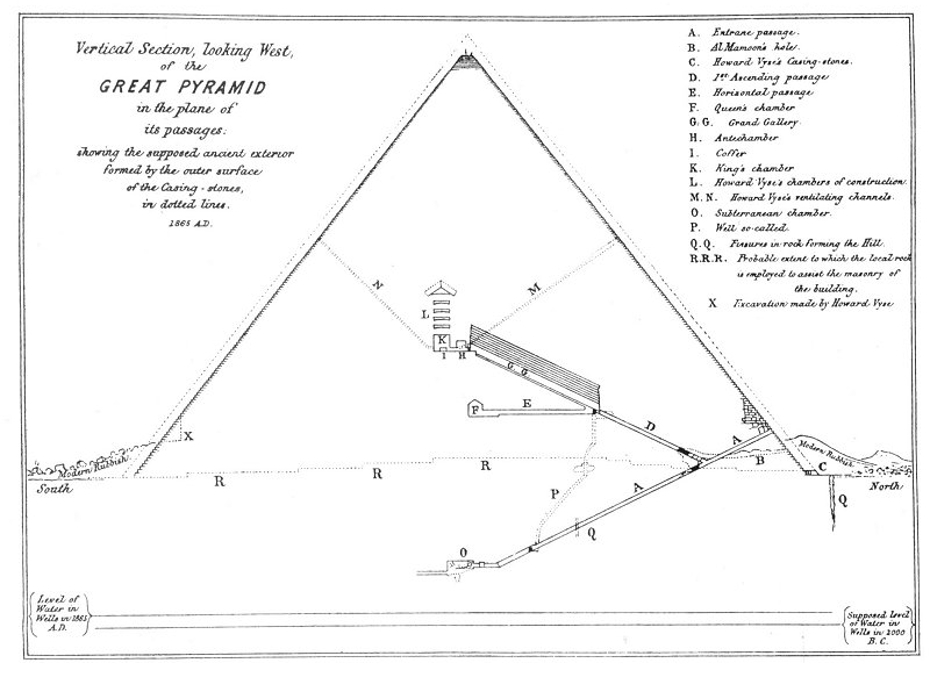
The Grand Gallery's orientation North-South in the Great Pyramid of Giza, : https://commons.wikimedia.org/wiki/File:The_Secret_Teaching_of_All_Ages_-_Chapter_6_-_Pyramid.jpg
32.09 The operating cycle of the impactor from the sledge point of view: Anubis and Wepwawet
The "Openers of the roads" excerpt from E. A. Wallis Budge, is crucial. Again, appears the apparent "obsession" of ancient Egyptians for the concept of "cycle"; everything seemed to be about a cycle, and here there is Anubis and Wepwawet who are parts of one of these cycles.
When Wepwawet was "opening the roads to the South", Anubis was "opening the roads to the North".
North/South; that is the orientation of the Grand Gallery of the Great Pyramid, with the ascending passage (the inclined well) at the North-end of the Gallery, and the top platform at the South-end.
Because both Anubis and Wepwawet are about the sledge (runners), then we can affirm that:
• Wepwawet is the deification of the sledge of the impactor, ascending the Grand Gallery towards South
• Anubis is the deification of the sledge of the impactor, after its release in the central caisson of the Gallery, gaining speed and energy until it rammed into the waters of the well
"According to E.A. Wallis Budge in The Gods of the Egyptians Anubis shared the duty of guiding the dead through the afterlife with another jackal-headed god ... "Opener of the Ways"). These two gods both "opened the ways", although Anubis was the opener of the roads of the North and Wepwawet the opener of the roads to the South. http://www.touregypt.net/featurestories/anubis.htm
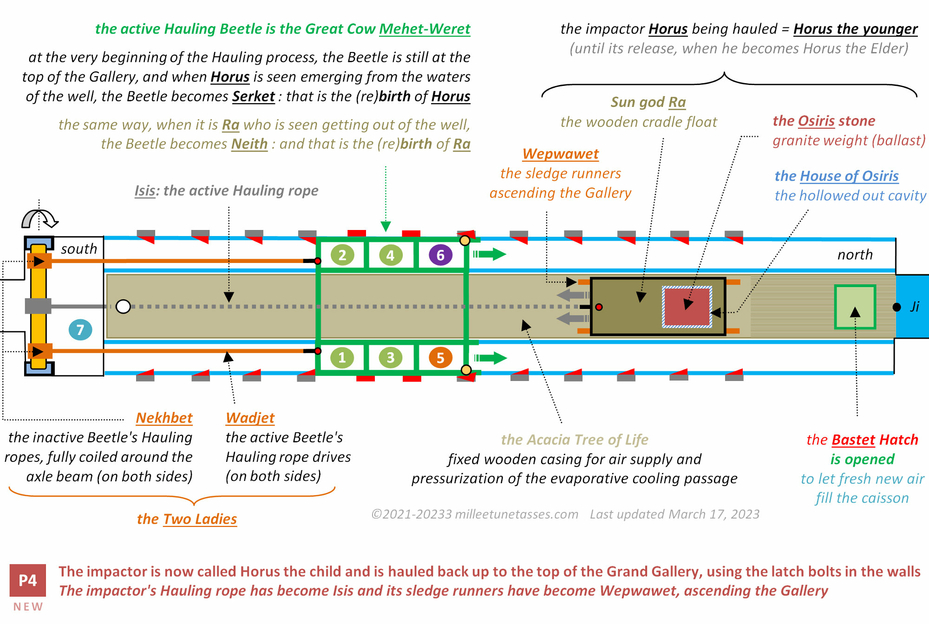
32.10 Operating cycle of the Grand Gallery Position P4
The impactor is now called Horus the child and is hauled back up to the top of the Grand Gallery, using the latch bolts in the walls. The impactor's Hauling rope has become Isis and its sledge runners ascending the Gallery have become Wepwawet.
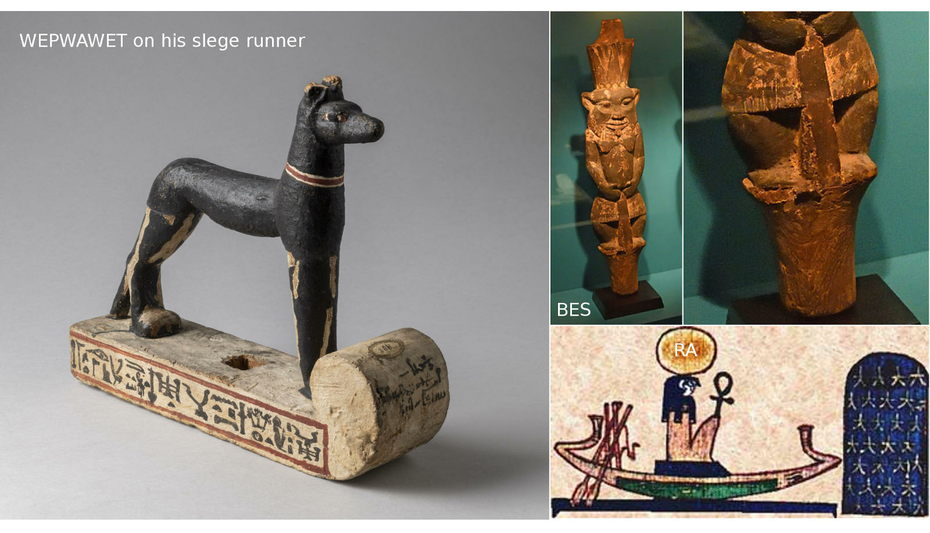
32.11 The beautiful concept of representing one single deity combined with its real meaning
We've already seen that ancient Egyptians used to represent one single idea (or object), in combined representations where this idea is shown in two different forms; one of the two forms being the intellectual deification of that idea (a god or a goddess who glorifies it), and the second one being a simple representation of the idea itself.
For example:
• Ra and his boat, as the deification of the wooden part of the impactor. Remember: there is no boat of Ra, because "Ra really is the boat".
• Bes on his "standing post", as the deification of the wedging block for Taweret who was at the bottom of the well during the entire operation of the Great Pyramid, with its thin and fragile extension protruding out of the inclined well floor. Bes is then simply represented resting onto himself.
• Now Wepwawet and the sledge runner: Wepwawet really is the sledge runner.
• Just below, we'll see that the same principle had been used on the giant statues of Anubis lifting the sledge into the air, because Anubis really is the sledge.
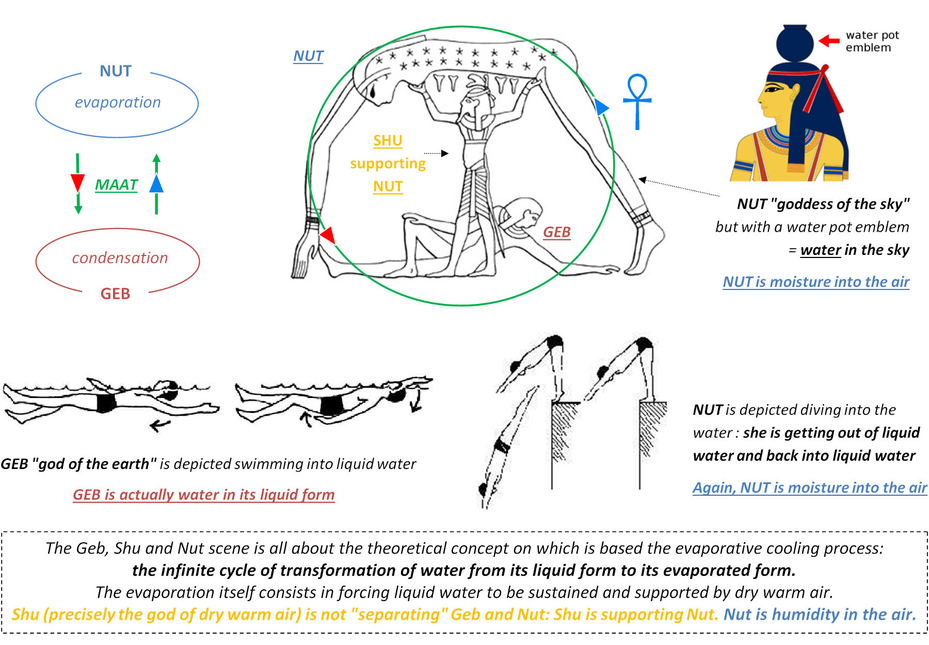
32.12 Wepwawet and Anubis are supposed to "lift" something into the air
This idea that Anubis and Wepwawet were combined together to be both parts of a cycle of some kind, is actually perfectly known:
"Anubis is associated with his brother Wepwawet, another Egyptian god portrayed with a dog's head or in canine form, but with grey or white fur. Historians assume that the two figures were eventually combined." https://en.wikipedia.org/wiki/Anubis
So we have Anubis and Wepwawet combined together, and when the first one is moving North, the second one is moving South.
But it doesn't end here, because we also know that Wepwawet referred to Shu; and we've already seen that Shu is not only all about a cycle of his own (the cycle of water, from its liquid form to its evaporated form), but he is also all about sustaining something into the air: Shu is represented sustaining/supporting/holding evaporated water into the air.
"Like Shu, he [Wepwawet] was also referred to as the "one who has separated the sky from the earth." http://www.touregypt.net/featurestories/wepwawet.htm
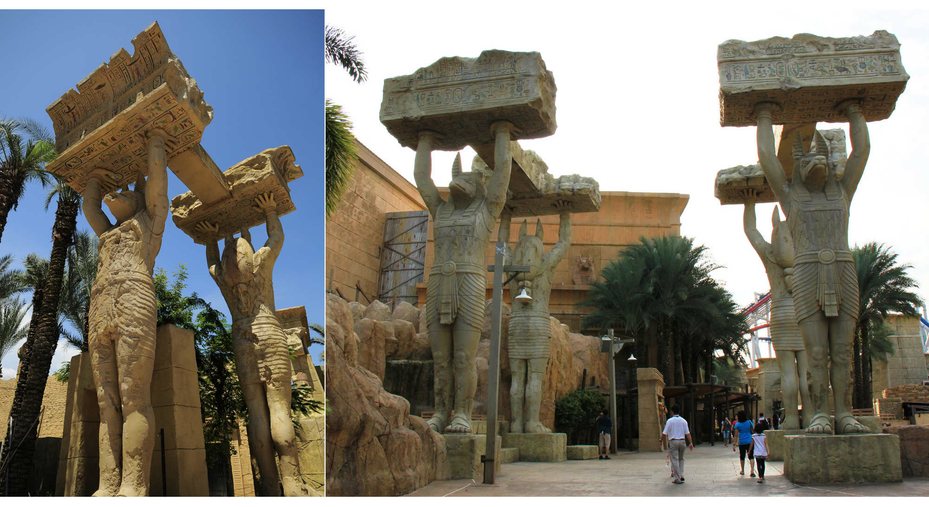
"Giant size realistic replicas of Ancient Egypt makes an impression at Universal Studios Singapore". Photograph by William Choe: https://www.flickr.com/photos/adforce1/5038237869/in/photostream/
and by John Wah 华约翰:https://www.flickr.com/photos/johnwah/6794236531
32.13 Anubis is indeed all about "lifting" (as the deification of the sledge, he is actually lifting himself up in the sky)
Unfortunately, I couldn't find any scientific information about the four giant replicas of Anubis' statues that are today at Universal Studios in Singapore; no archeological context what so ever, so their interpretation is kind of risky: they could possibly be not genuine material.
With that being said, these statues of Anubis are the perfect illustration of the "lifting" capacities of both Wepwawet and Anubis.
What needs to be seen here, from the ancient Egyptian point of view, is that when Wepwawet is represented standing on his sledge runner, or when Anubis is represented in his lifting position just like he is doing the clean-and-jerk exercise, both are actually about the sledge capacities: you can see it in both as a sliding and a lifting movement.
If these replicas of Anubis are genuine in their posture and lifting "intention", they would probably have been intended to represent the sledge lifted into the air.
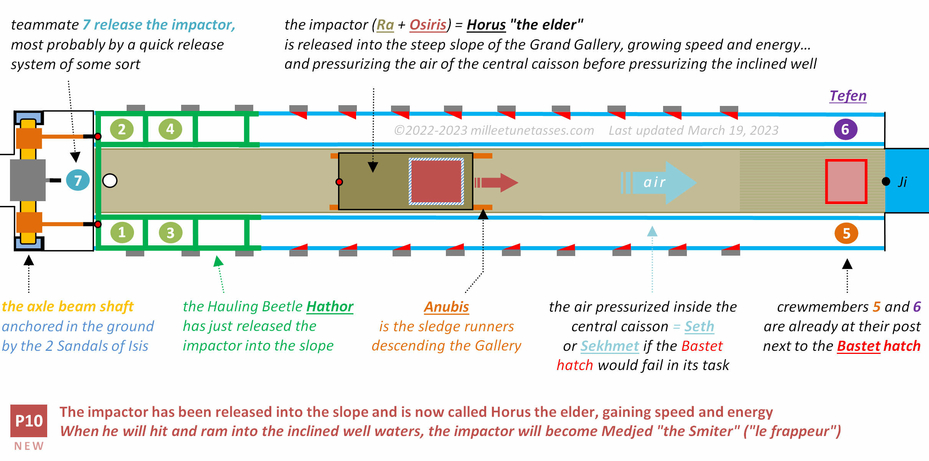
32.14 Operation of the Grand Gallery position P10: the release of the impactor
Other positions in previous Section 31
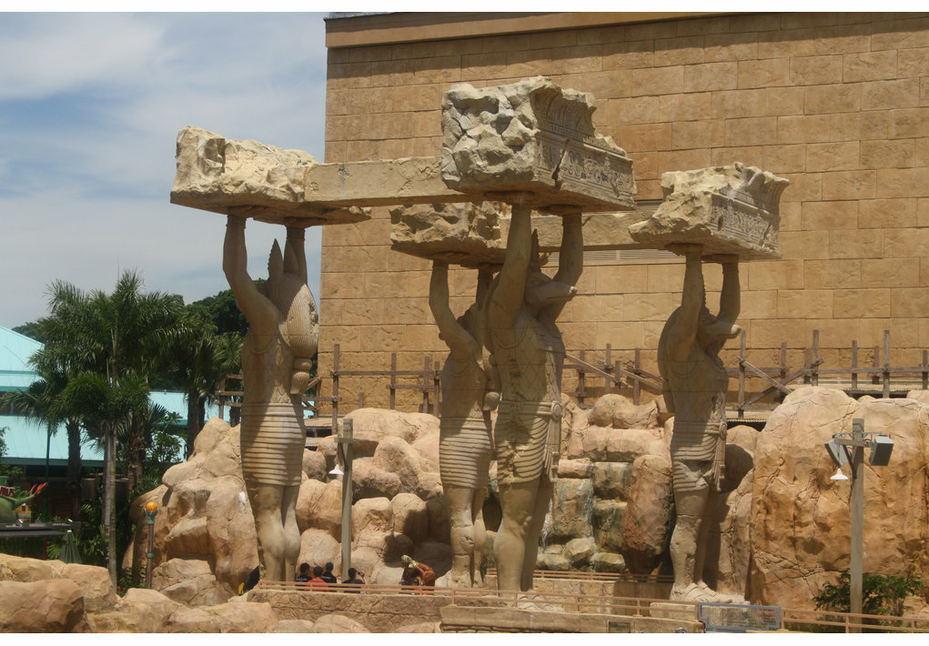
Giant size replicas of Ancient Egyptian god Anubis statues at Universal Studios, Singapore.
32.15 Why did the jackal-dog-wolf had been chosen as the metaphor of the sledge?
I must admit that for this particular question, I have not came up with a satisfactory response. Was it because of the way these animals were running like crazy in the country? Or because of the sound of the runners that would have maybe resemble to their howling? Or simply because of the way their four legs looked just like runners when they are in a recumbent position (see below)? I don't know, and it is probably because of something else.
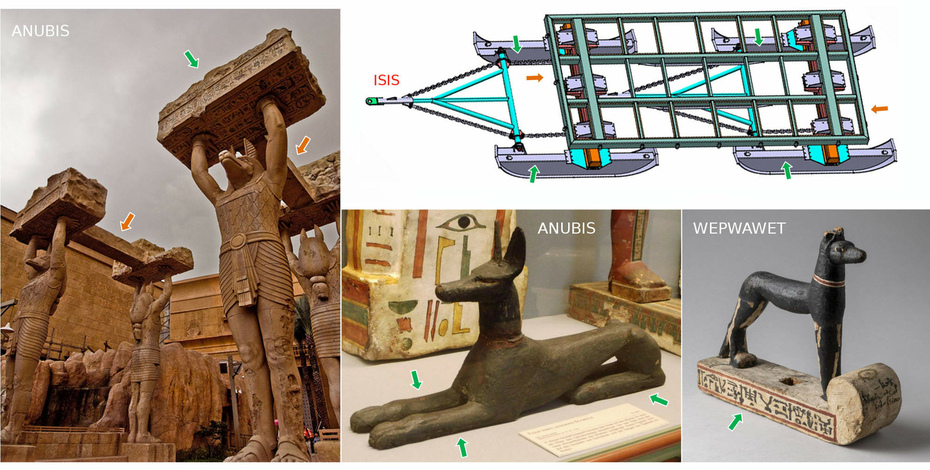
"Statues of Ancient Egypt" at Universal Studios Singapore, by verdandi_magic: https://en.wikipedia.org/wiki/Universal_Studios_Singapore#/media/File:Universal_Singapore_Ancient_Egypt_Statue.jpg
Technical sled drawing by Patrice Godon Polar Engineering (Plouzane, France): http://www.patricegodonpolarengineering.eu/sleds/
32.16 Did the sledge of the impactor had four runners like the four parallel paws of Anubis?
This is a very legitimate question to ask, and if we consider both the giant statues of Anubis and his recumbent representations with his four legs perfectly parallel and like nailed to the ground, it would suggest that the sledge had four runners.
I would have personally imagine two large runners, but maybe there really was four small ones, one underneath each corner of the impactor.
But we really have to take this four runners hypothesis with precaution, as we've already seen many times that ancient Egyptians used profusion of metaphors. Instead of having four runners on each corner, maybe the whole thing was to precisely describe everything "just like" there was four runners, when the sledge would only have two runners instead.
Would it be a practical reason for having four runners? Would it be more efficient, or more reliable? Wouldn't it be more fragile instead?
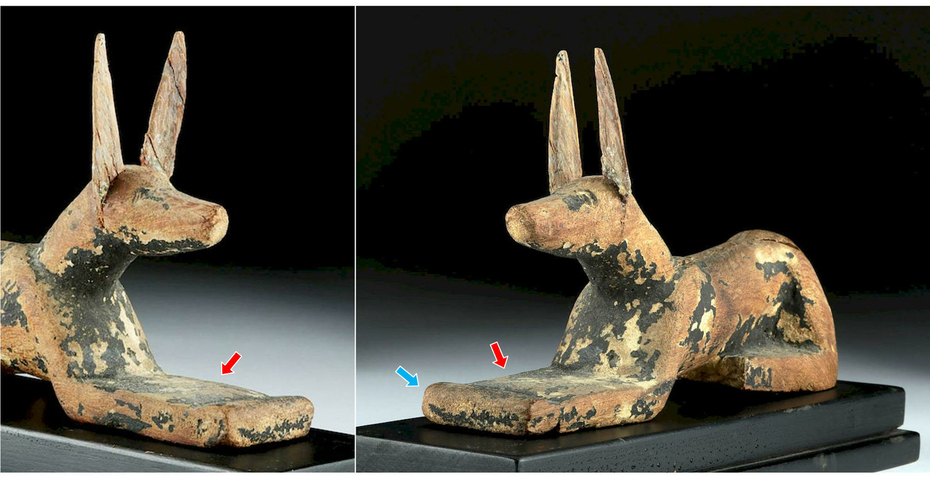
"Egyptian Late / Ptolemaic Wood Anubis Jackal Form" at Bidsquare: https://www.bidsquare.com/online-auctions/artemis-gallery/egyptian-late-ptolemaic-wood-anubis-jackal-form-1160578
32.17 Again, the legs perfectly paralleled and anchored into the floor seem to be the key of the jackal forms of Anubis
Most of the time the representations of Anubis in his fully jackal form are very well rendering the anatomy of the animal, but in very rare occasions, its true artificial nature can be seen on his legs. That probably is the confirmation that the reason, or one of the reasons, which incited ancient Egyptians to use the jackal/wolf/dog animal, is precisely its legs in their recumbent position, perfectly well anchored into the floor, just like sledge runners would be.
It even looks like the curved part at the front of the runner has been reproduced (blue arrow).
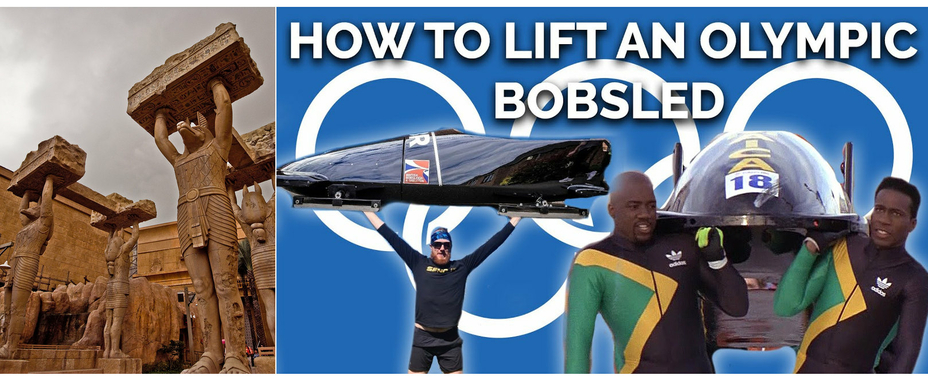
32.18 How to lift an Olympic (or ancient Egyptian) bobsled!
"Lifting an Olympic Bobsled - How bobsleds are moved", a video by Axe Racing: https://www.youtube.com/watch?v=qbUvsbfpGkE
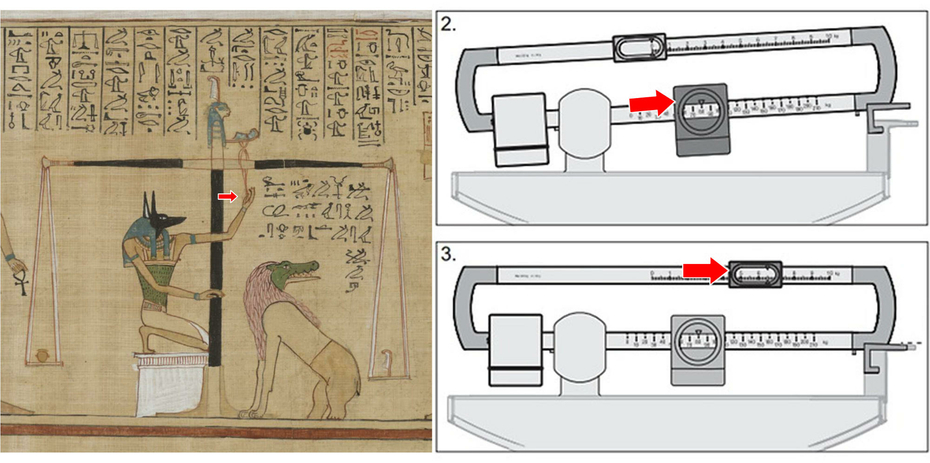
"Book of the Dead of Hunefer (Hw-nfr) showing Hunefer's judgement" at the British Museum, London : https://www.britishmuseum.org/collection/object/Y_EA9901-3
Scale adapted from the mechanical column scale, by Seca: https://www.seca.com/en_gb/company/stories/details/article/the-mechanical-column-scale-nostalgia-with-a-modern-spirit.html
32.19 The sliding metaphor used through Anubis in the weighing of the heart scenes
What is really magnificent, is not just how ancient Egyptian gods and goddesses have been used to encode everything that was done in a scientific and technological manner, but also how they used these same gods and goddesses, in a total different context from where they originated, as simple tools in completely different contexts and representations.
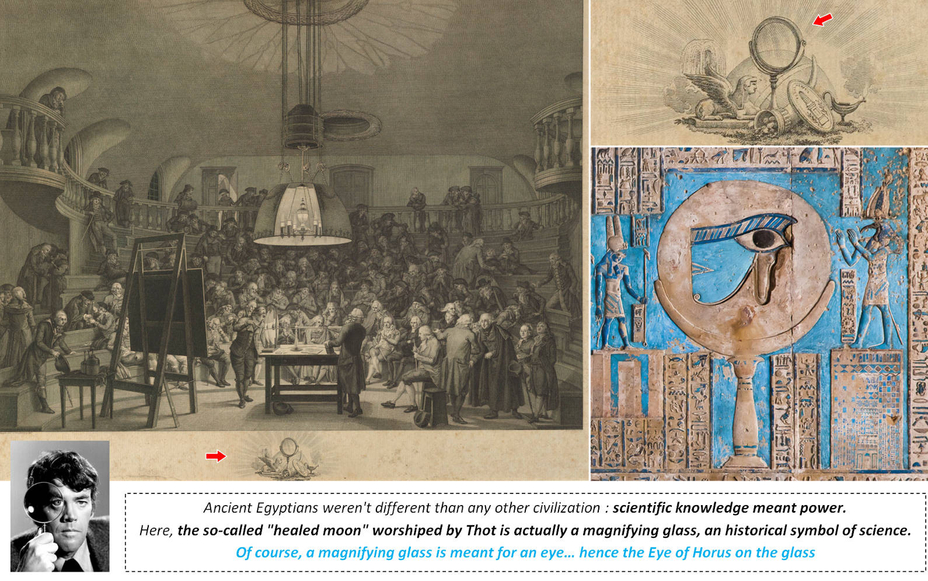
"This engraving shows Dutch mathematician and physicist Jean Henri van Swinden (1746–1823) demonstrating the generation of electricity to the Felix Meritis Society in Amsterdam. The Felix Meritis Society was founded in the late 18th century to promote the arts and sciences (Felix Meritis translates as "Happiness through Merit")". Barbiers, Pieter Pietersz., and Jacques Kuyper. Courtesy of Science History Institute in Philadelphia : https://digital.sciencehistory.org/works/zg64tm573
"The astronomical ceiling at the Pronaos, outer hypostyle hall in the Temple of Hathor in the Dendera Temple complex, near Dendera, Egypt. : detail of the first Band west from the centre, showing the full healed moon on a pillar depicted as "Wadjet" the Eye of Horus healed by Thoth, who is portrayed at the right." Thanks to Kairoinfo4U : https://www.flickr.com/photos/manna4u/9295311496
Jim Hutton as detective Ellery Queen, posing with a magnifying glass courtesy of NBC Television: https://en.wikipedia.org/wiki/Magnifying_glass#/media/File:Jim_Hutton_Ellery_Queen_1976.JPG
32.20 The Eye of Horus used just like Anubis as a simple metaphorical tool
We've already seen that with the Eye of Horus represented right in the middle of what simply is a magnifying glass (Table of Contents), because "a magnifying glass is only meant for an eye"; and here this is Anubis who has (almost) absolutely nothing to do in the "weighing of the heart" scene (Section 20), but who is just used because of his sledge sliding movement: the Anubis sledge was sliding up and down the Grand Gallery, and they used that image by making him "play" with the sliding counterweight of the scale. This is both beautiful and brilliant.
"A steelyard balance, steelyard, or stilyard is a straight-beam balance with arms of unequal length. It incorporates a counterweight which slides along the longer arm to counterbalance the load and indicate its weight. A steelyard is also known as a Roman steelyard or Roman balance." https://en.wikipedia.org/wiki/Steelyard_balance

If Ra is represented into a falcon, it is because of its speed and the way it is hitting its prey at high velocity : "The peregrine falcon is renowned for its speed, reaching up to 320 km/h (200 mph) during its characteristic hunting stoop (high-speed dive), making the peregrine falcon the fastest member of the animal kingdom." Ra, as a falcon is all about this high-speed dive and the force of the impact with its prey. Source: https://en.wikipedia.org/wiki/Peregrine_falcon
Ra-Horakhty is a combined deity of Horus and Ra, and is usually depicted as a falcon-headed man. Draw by Jeff Dahl: https://en.wikipedia.org/wiki/Ra#/media/File:Re-Horakhty.svg
Photograph of a high-speed diving falcon by Lassannn, on imgur and also at https://www.facebook.com/wildlifeatrisk/photos/a.442972959170883/1593597324108435/
Le réveil d'Osiris (the Awakening of Osiris) at the Exposition Osiris, Institut du Monde Arabe, by Gautier Poupeau
Skeleton infographic by the International Bobsleigh and Skeleton Federation: https://www.ibsf.org/en/our-sports/skeleton-info-graphics
32.21 The bobsled and skeleton metaphors
I'm sure many people are gonna be horrified I'm even considering associating ancient Egypt with a bobsled; but the fact is that the ancient Egyptians themselves did exactly that; not on Anubis but on Osiris; and if you don't see that Osiris is represented in the above image, in the exact perfect position which one takes onto a skeleton, there is nothing I can do more that I'm doing right now.
It is said that this position of Osiris, is the "awakening" position; but I dare anyone to wake up like that. Seriously.
If the Osiris position looks exactly like a perfect copy-paste of the "official" position recommended by the IBSF if you want to be a skeleton Olympic champion, it is simply because it really is all about the skeleton position.
The fact is that this Osiris skeleton position isn't the only reference to winter sports which have been used by ancient Egyptians as metaphors of the operation of the impactor: on the IBSF drawing, you have the sledge, the position and the helmet.
Well, ancient Egyptians also used the helmet; and that is what we call "the masks of Anubis".

"Mask" N 4096 from Le Louvre Museum, Paris. Numéro principal : N 4096. Matériau : figuier sycomore (Masque, partie supérieure : Ficus sycomorus L. Analyses Xylodata, Victoria Asensi Amoros, 2018), tamaris (mandibule articulée et dents : Tamarix type tetragyna: https://collections.louvre.fr/en/ark:/53355/cl010007896
Early bobsled mask, which somewhat resembles an American football helmet; by J.T. Macintosh: https://en.wikipedia.org/wiki/Bobsleigh#/media/File:Bobsled_Mask_1932.png
32.22 The mask of Anubis from the Louvre is just like every early bobsled mask with many holes for perspiration
First, I need to emphasize the fact that the mask of Anubis as shown on the above picture from the Louvre, is totally unique: Anubis is the only ancient Egyptian god (I know of) for whom had been realized such artifacts with all these holes around the head.
This mask is completely specific to Anubis, and the holes around the head are telling us that the mask is actually a helmet, and that it is all about the sledge, because it is a bobsled helmet.
And just like any ancient helmets of the kind, many holes were arranged all around the face and on the head, because these holes aren't for "lacing" as suggested on the technical sheet from the Louvre, but they are intended to evacuate perspiration.
Everything about Anubis is about the sledge.
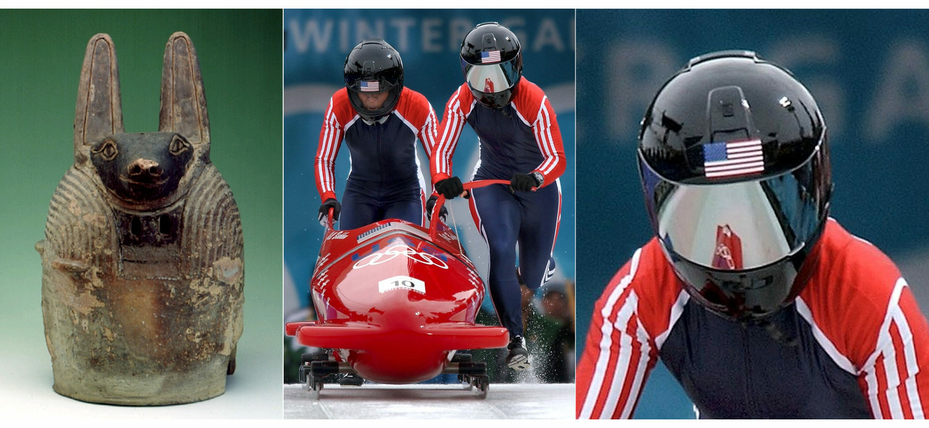
"Vonetta Flowers (left) and Jill Bakken power up in the push zone for their 80-mile-per-hour (130 km/h) ride down the Winter Olympic bobsledding track. Bakken, the driver, and Flowers, the brakeman, won the first gold medal presented in Olympic women's bobsledding (2002)". Photograph by U.S. Navy photo by Journalist 1st Class Preston Keres: https://en.wikipedia.org/wiki/Bobsleigh#/media/File:US_Navy_020219-N-3995K-304_Gold_Medal_Women_BobSledders_1.jpg
"This clay Anubis mask has two slits for the shoulders and two small holes for the eyes. It has been fashioned in clay in two parts. The massive muzzle and eyes were shaped as an independent whole, attached to the other part of the mask with a tenon. The tenon fits into a hole in the other part and a piece of wood was then driven through it to secure it". Anubis mask at the Pelizaeus-Museum at Hildesheim: http://www.globalegyptianmuseum.org/detail.aspx?id=10807
32.23 The evolution in the design of the Anubis mask followed the design of the bobsled masks
What is incredible is that even if the Anubis mask from the Louvre and the one from the Pelizaeus Museum at Hildesheim look very different, they actually are quite the same: the Anubis mask from the Louvre is simply about a leather helmet, when the one from Hildesheim is the equivalent of our modern hard-material shock-resistant helmets.
Ancient Egyptians simply added the head of the jackal onto the helmets.
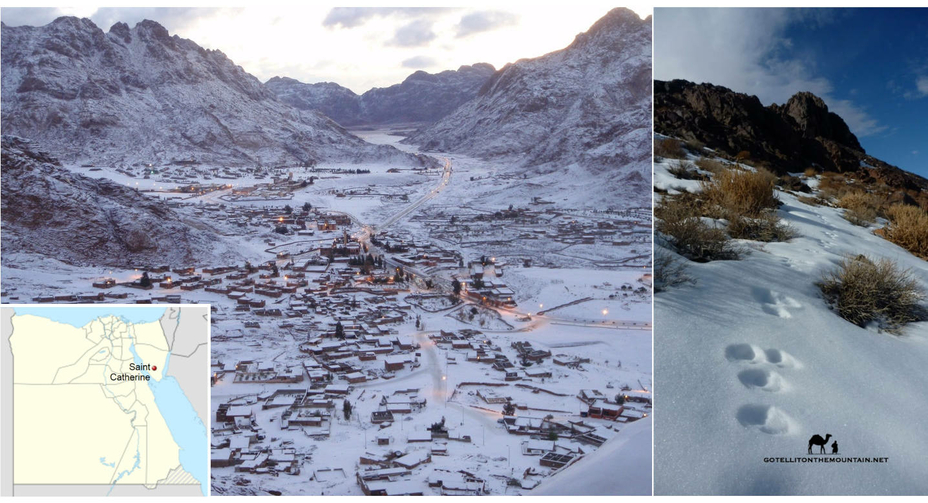
Snow in the town of Saint Katherine, Sinai Egypt, on the morning of March 1, 2009. Photograph by Zoltan Matrahazi https://en.wikipedia.org/wiki/Saint_Catherine,_Egypt#/media/File:Snow_in_St._Katherine,_Sinai_Egypt_-_March_1,_2009.jpg
Image on the right: © Go Tell It on the Mountain, A travel blog about discovering the high mountains of the Sinai, by Ben Hoffler: https://gotellitonthemountain.net/sinai-in-the-snow/
32.24 Where all these winter sport references are coming from?
At first sight, Egypt is not a country where you can expect snow, but it does happen on the high mountains of the Sinai; so the question is: are all the skeleton references coming from there, or did ancient Egyptians also used to go in foreign countries for winter?
It is definitely not the most important question to answer to, but it would have to be anyway, one day.
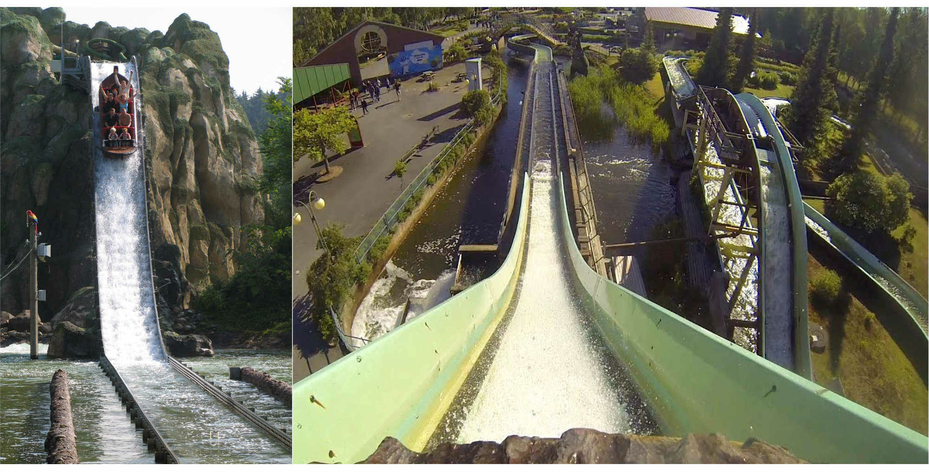
Log flume ride "Bûches de Legoland Deutschland", thanks to Stefan Scheer: https://www.wikiwand.com/fr/Attraction_aquatique#Media/Fichier:Legoland_Ger_Flume.jpg
Screenshot from the video "We Are On A Log Flume - Wasalandia Water Ride POV Finland", by Theme Park Review: https://www.youtube.com/watch?v=AOQoBpQS_mo
32.25 The log flume ride model
What is fantastic about the bobsled metaphors used to describe the way how the Grand Gallery has been used, is that it directly refers to the final goal of the process, which was producing cold, and that is brilliant; but the best way to really describe the operation of what really happened inside the central wooden caisson is with another sliding activity: the log flume ride.
In my opinion, the similarity between the log flume ride and the operation of the impactor, is pretty much perfect.
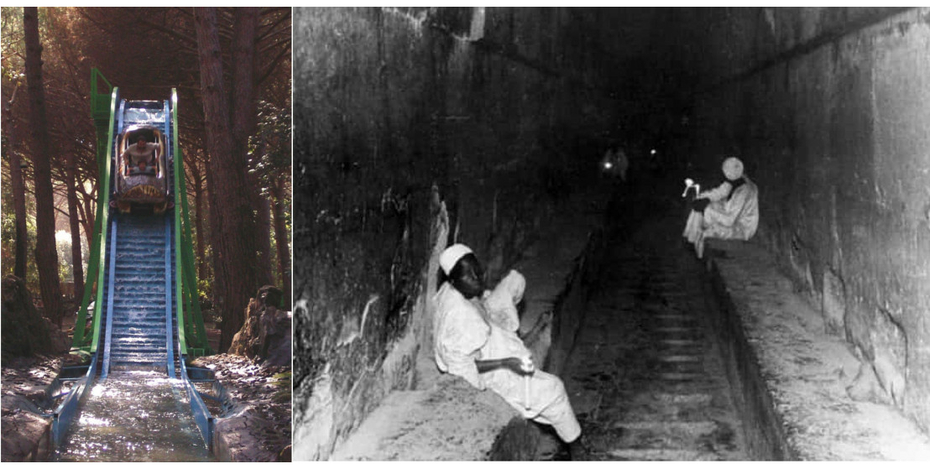
The Colorado Boats, by Emanuele Taddei: https://fr.wikipedia.org/wiki/B%C3%BBches_(attraction)#/media/Fichier:Colorado_Boats.JPG
Original image of the Grand Gallery of the Great Pyramid of Egypt at Giza, built by pharaoh Khufu, from page 52 of "The call of the stars; a popular introduction to a knowledge of the starry skies with their romance and legend" (1919) by Kippax, John R. (John Robert), 1849-1922 : https://www.flickr.com/photos/internetarchivebookimages/14597229618/
32.26 The mysterious horizontal lines of the central gutter in the Grand Gallery
The similarity of the operation of the central gutter of the Gallery with modern rides, is even reinforced by the mysterious lines that are showing on the above photograph taken in the early 1900's: the modern log flume ride chutes are showing the exact same pattern of horizontal lines which seem to produce many little chutes within the big one.
Again, I have no idea what is the purpose of these structures, but it seems that most of the rides have this design and that ancient Egyptians seem to have done the exact same thing in the Great Pyramid.
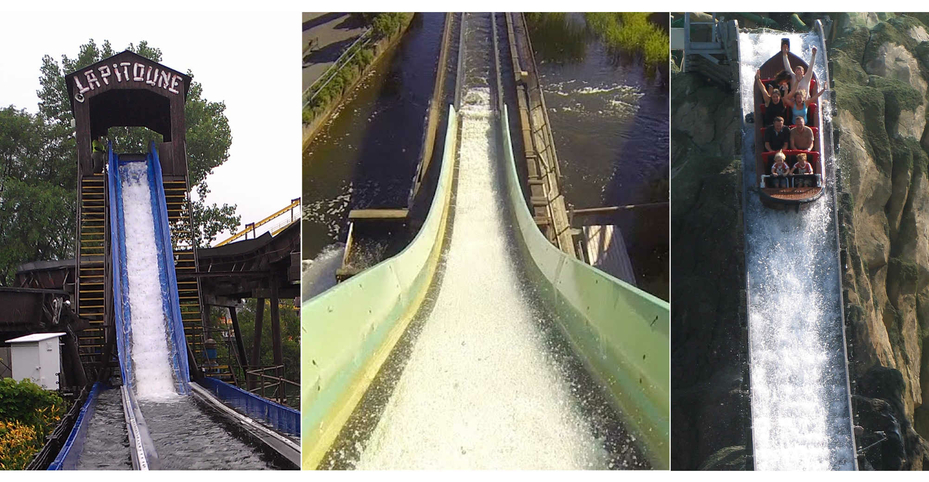
Left: "The Pitoune at La Ronde (Montreal, Quebec)": https://parkvault.files.wordpress.com/2015/04/imag2774.jpg
32.27 The "boiling" water of the log flume ride chute and the "frothing beer" of Anubis
And actually, it could even be more similar that I expected. At this point I would like to draw your attention to the way that the water looks like "boiling" right at the beginning of the big chute of the ride; I've tried to find some technical informations about how and why there is this "boiling" water, in what seems to be the vast majority of such rides, but I didn't succeeded; the only thing I know, is that there is an ancient Egyptian tale about Anubis which is called "the tale of the Two Brothers", obviously about Anubis (the deification of the sledge and its runners), and his younger brother Bata:
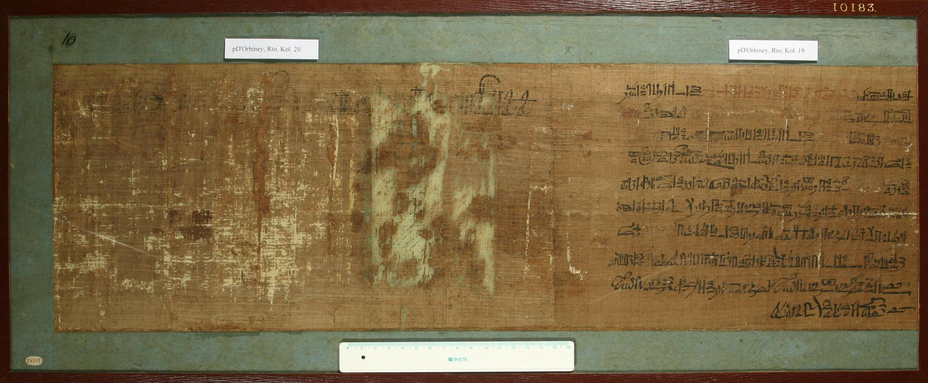
The tale of the Two Brothers papyrus at the British Museum: https://www.britishmuseum.org/collection/object/Y_EA10183-10
32.28 The tale of the Two Brothers, Anubis and Bata
"The story centers around two brothers: Anpu (Anubis), who is married, and the younger Bata. The brothers work together, farming land and raising cattle. One day, Anpu's wife attempts to seduce Bata. When he strongly rejects her advances, the wife tells her husband that his brother attempted to seduce her and beat her when she refused. In response to this, Anpu attempts to kill Bata, who flees and prays to Re-Harakhti to save him. The god creates a crocodile-infested lake between the two brothers, across which Bata is finally able to appeal to his brother and share his side of the events. To emphasize his sincerity, Bata severs his genitalia and throws them into the water, where a catfish eats them.
Bata states that he is going to the Valley of Cedars, where he will place his heart on the top of the blossom of a cedar tree, so that if it is cut down Anpu will be able to find it and allow Bata to become alive again. Bata tells Anpu that if he is ever given a jar of beer that froths, he should know to seek out his brother. After hearing of his brother's plan, Anpu returns home and kills his wife. Meanwhile, Bata is establishing a life in the Valley of the Cedar, building a new home for himself. Bata comes upon the Ennead, or the principal Egyptian deities, who take pity on him. Khnum, the god frequently depicted in Egyptian mythology as having fashioned humans on a potters' wheel, creates a wife for Bata. Because of her divine creation, Bata's wife is sought after by the pharaoh. When the pharaoh succeeds in bringing her to live with him, she tells him to cut down the tree in which Bata has put his heart. They do so, and Bata dies.
Anpu then receives a frothy jar of beer and sets off to the Valley of the Cedar. He searches for his brother's heart for three years and then another four years, finding it after searching for seven years. He follows Bata's instructions and puts the heart in a bowl of cold water. As predicted, Bata is resurrected.
Bata then takes the form of a bull and goes to see his wife and the pharaoh. His wife, aware of his presence as a bull, asks the pharaoh if she may eat its liver. The bull is then sacrificed, and two drops of Bata's blood fall, from which grow two Persea trees. Bata, now in the form of a tree, again addresses his wife, and she appeals to the pharaoh to cut down the Persea trees and use them to make furniture. As this is happening, a splinter ends up in the wife's mouth, impregnating her. She eventually gives birth to a son, whom the pharaoh ultimately makes crown prince. When the pharaoh dies, the crown prince (a resurrected Bata) becomes king, and he appoints his elder brother Anpu as crown prince. The story ends happily, with the brothers at peace with one another and in control of their country."
https://en.wikipedia.org/wiki/Tale_of_Two_Brothers
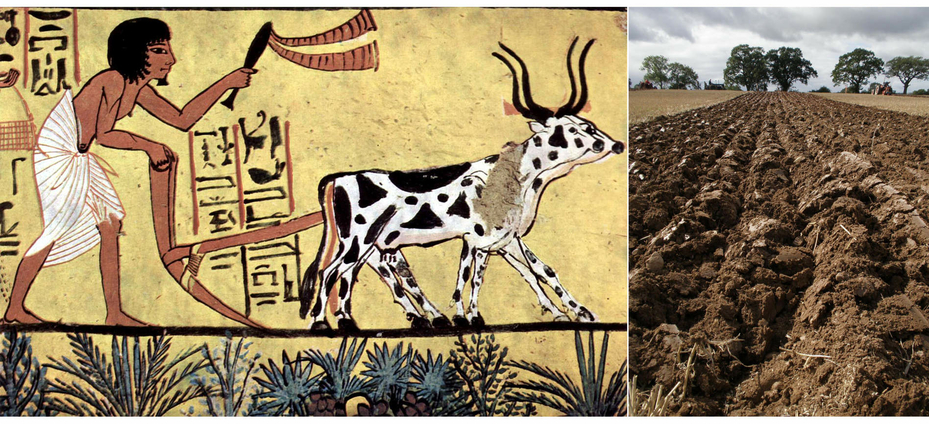
"Plowing farmer" in the burial chamber of Sennedjem: https://en.wikipedia.org/wiki/File:Maler_der_Grabkammer_des_Sennudem_001.jpg
Ploughed field: https://commons.wikimedia.org/wiki/File:Furrows,_ploughed_field.jpg
32.29 The Tale of Two Brothers: the sledge runners and their tracks
This tale is just like all the other myths we've already seen, ant it is packed with metaphoric representations of, in that case, the operating of the Grand Gallery, focusing onto the sledges.
I'm saying sledges, because it is not just about the Anubis sledge of the impactor: Anubis' younger brother (hence "smaller" brother) Bata, is all about the sledges of the Hauling half-beetles. This is why the context is a farm and Bata is working for Anubis.
In the tale, Anubis is actually the plough that creates the furrow (because he is the sledge, running into its tracks), and Bata is the one hauling the plough (because he is about the hauling beetles, on their own runners and running in their own tracks). If you keep that in mind, then you can understand that Anubis' wife is the tracks; this is why Anubis cannot kill his brother Bata: they are simply not on the same tracks.
"This myth is a little different as it fits outside of the Osiris-centric mythological canon. Instead of the normal cast of Egyptian gods and goddesses, the ancient god Bata starred alongside Anubis. Anubis’s younger brother Bata worked on his brother’s farm. One day, while doing chores for his brother, Bata ran into Anubis’s wife. She was quite taken with what she saw, and invited Bata to bed with her. Shocked at this invitation, Bata told her “you have been to me as a mother and what you say is an abomination!” He promised he would tell no one of the incident so long as she never spoke of this again. Anubis’s wife, however, had other plans. When Anubis came home, she pretended that Bata had beaten her, saying that he had propositioned her and struck her when she declined. Now enraged, Anubis attempted to kill his brother. Try as he might, however, he could not harm Bata; divine intervention prevented Anubis from taking his revenge."
Meehan, Evan. “Anubis.” Mythopedia, November 29, 2022. https://mythopedia.com/topics/anubis

The Timber Mountain Log Ride, by Metro96: https://upload.wikimedia.org/wikipedia/commons/2/2b/Timber_Mountain_Log_Ride_20.jpg
32.30 The moment when the "wine without froth" turns into "frothing beer"
I know it is a pretty long text, and it is all about the operation of the sledge in the Grand Gallery, but there is the excerpt that is very interesting: "Bata tells Anpu [that is Anubis] that if he is ever given a jar of beer that froths, he should know to seek out his brother".
In another text it says: "After dawn and the next day had come about and after the pine tree had been cut down, Anubis, the elder brother of Bata, entered his house and sat down and washed his hand(s). He was handed a beaker of beer, and it produced froth. Another of wine was handed him, and it turned bad. Then he took his staff and his sandals as well as his clothes and his weapons, and he hastened to journey to the Valley of the Pine".
From "The literature of ancient Egypt"; translations by R. O. Faulkner, Edward F. Wente Jr and William Kelly Simpson: https://uh.edu/honors/human-situation/survival-kit/study-aids/TwoBrothers.pdf
In the Anubis tale, it is clearly mentioned that this is the froth that is important, it is not the beverage itself, nor it is about the alcohol, it is only about the froth of the beer. My feeling about this, is that the "froth" of the Anubis tale, which is all about the operation of the sledge, is directly referring to the "boiling" water of the modern log flume ride chutes.

"Rainbows can form in the spray of a waterfall (called spray bows)", by Captain76: https://en.wikipedia.org/wiki/Rainbow#/media/File:Double_Rainbow_with_Niagara_Falls.jpg
32.31 The rainbow metaphor of the Anubis sledge sitting upon an "unparalleled and large bull that has every beautiful color"
It is hard to remember at all times, that everything about ancient Egypt is purely metaphoric, but once in a while you stumble upon a metaphor so cute that it like strikes you in the head; and this one, the "large bull that has every beautiful color, whose sort is unparalleled" is just one of them.
The context here is still the "boiling frothing beer", and froth is simply tiny little drops of water stuck into the air; that is also what is what is called a Spray bow: a rainbow caused by tiny little drops of water in the air.
The "beautiful color whose sort is unparalleled": that is the rainbow (the Spray bow), and that is the description of the impactor "sitting" onto that Spray bow, i.e. "sitting" onto sprayed water. The "frothing beer" is the "sprayed boiling" water that is making the impactor move into the central caisson.
"After dawn and the next day had come about and after the pine tree had been cut down, Anubis, the elder brother of Bata, entered his house and sat down and washed his hand(s). he was handed a beaker of beer, and it produced froth. Another of wine was handed him, and it turned bad."
"Then Bata said to his elder brother: Look, I shall become a large bull that has every beautiful color and whose sort is unparalleled, and you shall sit upon back. After dawn / and the next day had come about, Bata changed into the form which he had mentioned to his elder brother. Then Anubis, his elder brother, sat down upon his back until dawn, and he reached the place where the king was."

Typical English flat irons of the 1800s (Collection Tranby House, Australia). The shape was used by Victorian antiquarians to describe a style of medieval shield, termed by analogy heater shield. Photograph by Gnangarra: https://en.wikipedia.org/wiki/Clothes_iron#/media/File:Tranby_house_21_gnangarra.jpg
32.32 The "hot iron" metaphor of the sledge runners true nature of Anubis
Seth is central in the ancient Egyptian mythology, and he is all by himself fighting the two most important Egyptian deities: Osiris and Anubis.
We've already seen that when Seth is fighting Osiris, it is because Seth is the deification of the pressurized air inside the central caisson of the Grand Gallery, and that it is about pressurized air "fighting" against the weight of the impactor (the Osiris stone) during its descent in the Gallery.
In the tale of the Two Brothers, the same Seth is now fighting Anubis, because the impactor had to be set onto a sledge equipped with two large of four smaller runners.
The fight between Seth and Anubis is about pressurized air "fighting" the sledge during the descent of the impactor.
In the tale, the true nature of Anubis is even mentioned, metaphorically of course; this time the metaphor is about a "hot iron": in some ways the endless sliding movement of the runners would indeed looked exactly like "hot irons" moving up and down the Gallery.
"While Set had succeeded in killing Osiris, he still needed to destroy his brother’s body in order to defeat him completely. After Osiris’s body was recovered by Isis, Set plotted to steal it back and complete its destruction. During the embalming process, Osiris’s body was kept in the wabet, or place of embalming. Noting that Anubis left the wabet every night, Set devised a plan. Transforming himself into Anubis, he strolled past the unsuspecting guards and stole Osiris’s body.
Set would not able to make it far, however, before Anubis discovered the theft and set out in pursuit. In an attempt to ward off his pursuer, Set turned himself into a bull. The jackal-god was not intimidated, however. Upon capturing Set, Anubis castrated him and imprisoned him in Saka, the 17th nome of Egypt.
Not one to be deterred, Set escaped his imprisonment and continued his mission. This time, Set attempted to steal his brother’s body in the form of a great cat. The plan failed, and Anubis caught him once more; the jackal-headed god punished Set by branding him with hot irons. This myth thus explained how leopards became spotted.
Ever persistent, Set continued trying to steal Osiris’s body back. Again, he turned himself into Anubis, and again he was caught. Set was forced to serve as Osiris’s throne for all eternity—that is, until he escaped.
Set’s next attempt would be his last. After catching Set yet again, Anubis killed him, flaying his skin and setting his body aflame. After donning the flayed skin, Anubis snuck into Set’s camp and decapitated his entire army with a single slash of his sword. Set’s army was killed in the 18th nome, where a reddish mineral makes the land appear stained with blood."
Source: Meehan, Evan. “Anubis.” Mythopedia, November 29, 2022. https://mythopedia.com/topics/anubis
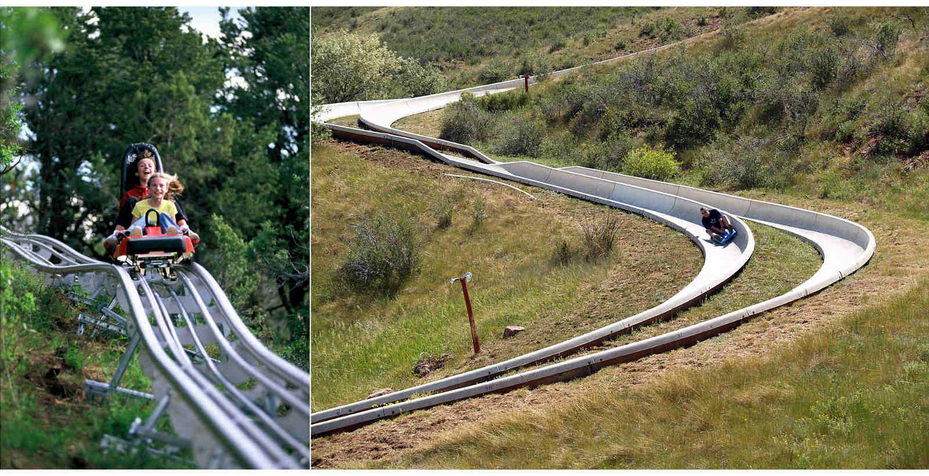
"The dips of the Wiegand alpine coaster at the Eifelpark in Rhineland-Palatinate, Germany", by Eifelpark GmbH: https://en.wikipedia.org/wiki/Summer_toboggan#/media/File:Eifelpark_Eifel-Coaster.jpg
"Alpine slide in Heritage Square, Golden, Colorado", by Charles Willgren: https://en.wikipedia.org/wiki/Summer_toboggan#/media/File:Alpine_Slide_in_Golden.jpg
32.33 The "road" and "guide" metaphors of the Anubis sledge runners perfectly set into their tracks
There is another metaphor concerning the true nature of Anubis, as the glorification of the sledge runners: the "guide" metaphor. It also has to be pointed out another equivalent metaphor: the road metaphor; as we've already seen that Anubis (as well as Wepwawet) were called the "openers of the roads".
The roads and guide metaphors are about the sledge runners and their tracks.
"In the Old Kingdom, Anubis was the most important god of the dead. He was replaced in that role by Osiris during the Middle Kingdom (2000–1700 BC).[17] In the Roman era, which started in 30 BC, tomb paintings depict him holding the hand of deceased persons to guide them to Osiris." https://en.wikipedia.org/wiki/Anubis
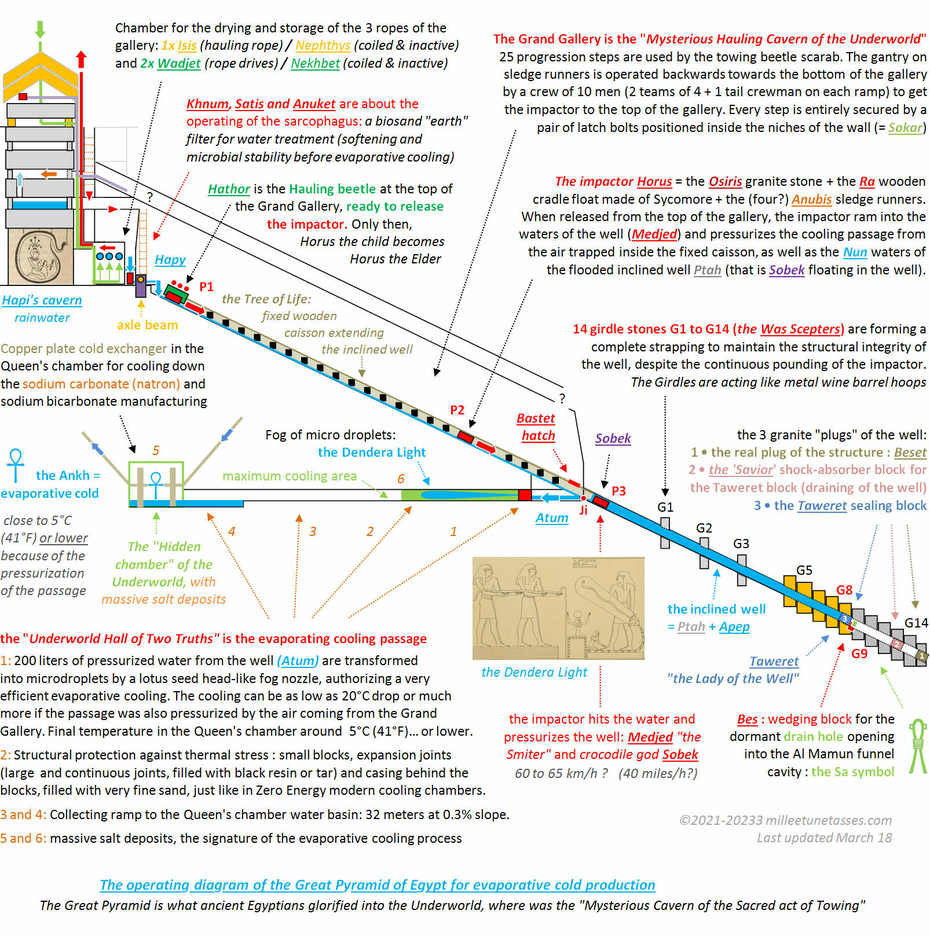
32.34 The operation of the Great Pyramid of Giza for evaporative cold production into the Queen's chamber.
Last updated March 18, 2023.
32.35 The first gods and the beginnings of the "pharaonic scientific era" triggered by the Hauling beetle "motor"
One very important point about everything I've written so far, is the fact that it may appears like I'm only focusing the work on the Great Pyramid, but it is only simply because it is (or it looks like) the achievement of what could be called the "pharaonic scientific era". It seems that era stopped abruptly at the end of the Fourth Dynasty and the construction of the pyramid of Khafre, Khufu's son; and it is also clear that most of the ancient Egyptian religion texts seem to really get into gear just at that moment; for example the "Pyramid Texts" and many deities, are starting to show only with the Fifth Dynasty.
"The Pyramid Texts are the oldest ancient Egyptian funerary texts, dating to the late Old Kingdom. They are the earliest known corpus of ancient Egyptian religious texts. Written in Old Egyptian, the pyramid texts were carved onto the subterranean walls and sarcophagi of pyramids at Saqqara from the end of the Fifth Dynasty, and throughout the Sixth Dynasty of the Old Kingdom, and into the Eighth Dynasty of the First Intermediate Period. The oldest of the texts have been dated to c. 2400–2300 BCE." https://en.wikipedia.org/wiki/Pyramid_Texts
Anubis is one of the deities who can be traced way before the Great Pyramid; others like Hathor are unclear but also seem to have a "previous life" before the Fourth Dynasty and the Great Pyramid.
"In Egypt's Early Dynastic period (c. 3100 – c. 2686 BC), Anubis was portrayed in full animal form, with a "jackal" head and body. A jackal god, probably Anubis, is depicted in stone inscriptions from the reigns of Hor-Aha, Djer, and other pharaohs of the First Dynasty." https://en.wikipedia.org/wiki/Anubis
"Despite these early precedents, Hathor is not unambiguously mentioned or depicted until the Fourth Dynasty (c. 2613–2494 BC) of the Old Kingdom, although several artifacts that refer to her may date to the Early Dynastic Period (c. 3100–2686 BC). When Hathor does clearly appear, her horns curve outward, rather than inward like those in Predynastic art". https://en.wikipedia.org/wiki/Hathor
We've seen that Hathor is the deification of the Hauling beetle, at the top of the Grand Gallery and that she is the one who released the impactor; and this is very important, because I would bet that most of the ancient Egyptian gods who can be traced way before the Fourth Dynasty, were all involved in the couple which constituted the Hauling beetle and the impactor.
What triggered the Industrial revolution in our modern era, during the 18th and 19th centuries was the steam engine; it did make all the difference, and I bet that this is the association of the Hauling beetle with the Sledge which made all the difference for ancient Egyptians, whether this couple was associated with an "impactor" like in the Great Pyramid (specifically designed to pressurize air and water), or used as a simple hauling tool to move blocks.
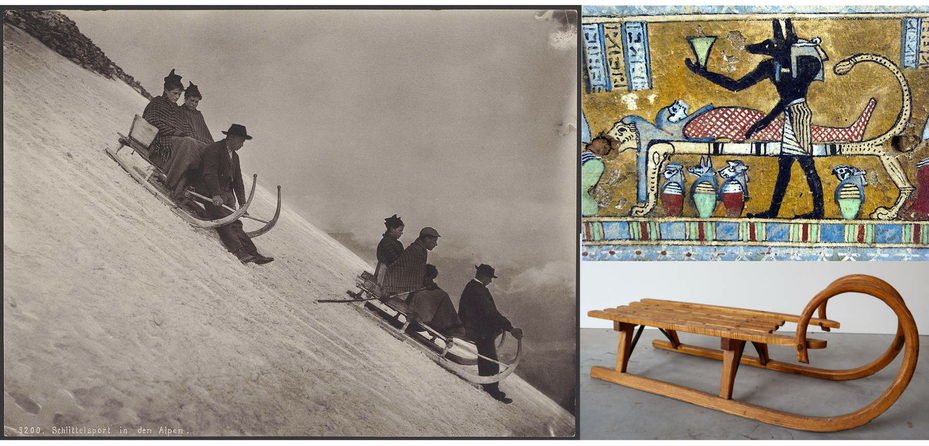
Schlitteln, Schweizer Alpen, 1890-1910: https://en.wikipedia.org/wiki/Sledding#/media/File:Zentralbibliothek_Z%C3%BCrich_-_Schlittelsport_in_den_Alpen_-_000012146.jpg
"Anubis, supervisor of the mummification process. Underneath the lion bed are the four canopic vases, for the organs that were mummified separately". Photograph of a wooden sarcophagus, by Andre: https://www.flickr.com/photos/9987501@N08/3643941456/
Sledge from the Davidowski collection: https://www.davidowski.nl/collections?searchTerm=sledge
32.36 The "decay" of the sledge runners and the operation time of the Great Pyramid
There is one epithet of Anubis which is very troubling if you only consider the academic vision of the god, and that is the fact that the ancient Egyptian root of Anubis' name "inp", means "to decay".
And that brings us to discuss the question of how long was the Great Pyramid in operation.
Knowing that Anubis is the glorification of the sledge, and/or more precisely the deification of the sledge runners, the problematic of the runners wearing off other time let us think that this operation time of the Pyramid could have been over a long, or very long period of time.
I would personally tend to think about a few years; and that echoes a passage of the tale of the Two Brothers: "Anpu [that is Anubis] then receives a frothy jar of beer and sets off to the Valley of the Cedar. He searches for his brother's heart for three years and then another four years, finding it after searching for seven years. He follows Bata's instructions and puts the heart in a bowl of cold water. As predicted, Bata is resurrected."
Of course, this part of the study is very risky and hypothetical, I agree, but if we don't start somewhere, we'll accomplish nothing and will never come close to what really happened.
The question is why is it mentioned a period of 3 years, and then another period of 4 years. Of course, all these years could really only be metaphors referring to the 7 teammates of the Grand Gallery's operation; maybe.
But I'm seeing something else, something that is maybe starting to answer one question that troubles me for a very long time now: why did Khufu's son Khafre built one last great pyramid, just next to his father's?
The (extremely hypothetical) answer I'm suggesting, is as follows:
• Khufu build the Great Pyramid, then operates it for 3 years before dying or giving up the throne
• Khafre then takes over the throne and operates the Great Pyramid for another 4 years, before celebrating the achievement and building his own pyramid that concludes the "engineer era" of ancient Egypt.
Again, this last part is getting very close to science-fiction, but who knows?
When Zahi Hawass, cleaned up the massive salt deposits which accumulated in the Queen's chamber and the evaporative passage in 1998 (Section 1), thus destroying the evidence of the evaporative cooling process itself, not only we probably definitely lost the ability to exactly know how efficient was the ancient Egyptian design (the size of the crystals would have told us the temperature of crystallization), but we also lost the ability to valid or invalid this 7 years of operation hypothesis (by studying the layers of crystallization).
"Anubis, also known as Inpu, Inpw, Jnpw, or Anpu in Ancient Egyptian is the god of funerary rites, protector of graves, and guide to the underworld, in ancient Egyptian religion, usually depicted as a canine or a man with a canine head."
"Anubis" is a Greek rendering of this god's Egyptian name. Before the Greeks arrived in Egypt, around the 7th century BC, the god was known as Anpu or Inpu. The root of the name in ancient Egyptian language means "a royal child." Inpu has a root to "inp", which means "to decay." https://en.wikipedia.org/wiki/Anubis
32.37 The iconic scene of Osiris lying on his bed and Anubis "caring" for him
This is probably the most iconic representation of the ancient Egyptian religion, and now with the deciphering of Anubis, we can decipher the entire scene: of course Anubis is associated with mummification (he has indeed a major role in the creation process of the evaporative cold that most probably would have been used to cool down the manufacturing of 100% pure sodium carbonate natron), but here he is only "taking Osiris" by the hand, so to speak.

Edited from "Tomb of Sennedjem Deir el-Medina, TT1", by kairoinfo4u: https://www.flickr.com/photos/manna4u/14425902021/in/photostream/
32.38 Osiris lying on his sledge bed, and again Anubis represented twice in the same scene
Osiris laid on the bed is actually the Osiris stone (hence the composite impactor in its entirety) resting on the sledge, and that is Anubis himself. It is the same thing that we've already seen earlier in this Section: on that scene, Anubis is represented twice:
• the jackal-headed god is Anubis (the deification of the sledge)
• the bed on which is laid Osiris, is also Anubis, the sledge itself
If you pay attention to the tail of the lion-headed bed, it looks like it is merging with Anubis, where his own tail should be.
This "merging tail" metaphor, one more, we've already seen it with the Great Serpent Apep merging its tail with a baboon.
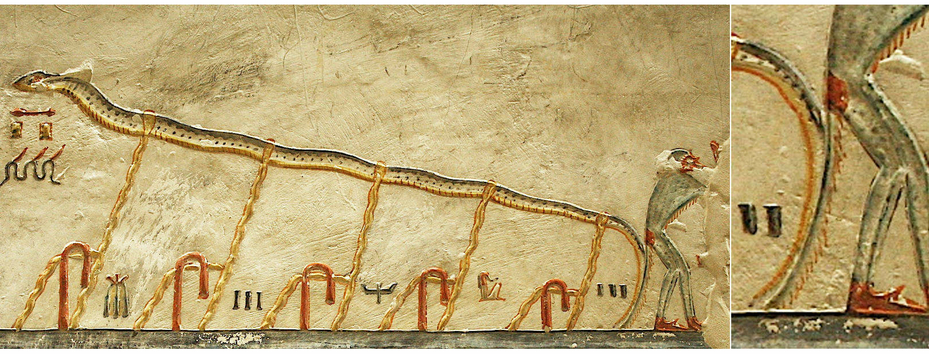
Apep, the Great Serpent Apophis, bound in Tomb KV9 in Egypt's Valley of the Kings, originally constructed for Pharaoh Ramesses V, 20th Dynasty: https://en.wikipedia.org/wiki/KV9
32.39 The running waters of Hapy giving birth to the pressurized but restrained waters of the inclined well
I don't think that the Osiris-Anubis "tail-gate" is simply a happy coincidence, because we've already seen that the exact same trick had already been used with the tail of a baboon merging into the tail of the Great Serpent Apep.
And because we've seen in previous Section 31, that the baboon Hapy is the representation of the waters "running" down the (central caisson of the) Grand Gallery, we wan even better decipher that image: the baboon (the running waters) is simply shown giving birth to Apep (the pressurized waters of the well).
Here, the waters are pressurized but contained and restrained by the well. The ropes restraining Apep are probably directly referring to the girdle stones (Section 4 and 5).
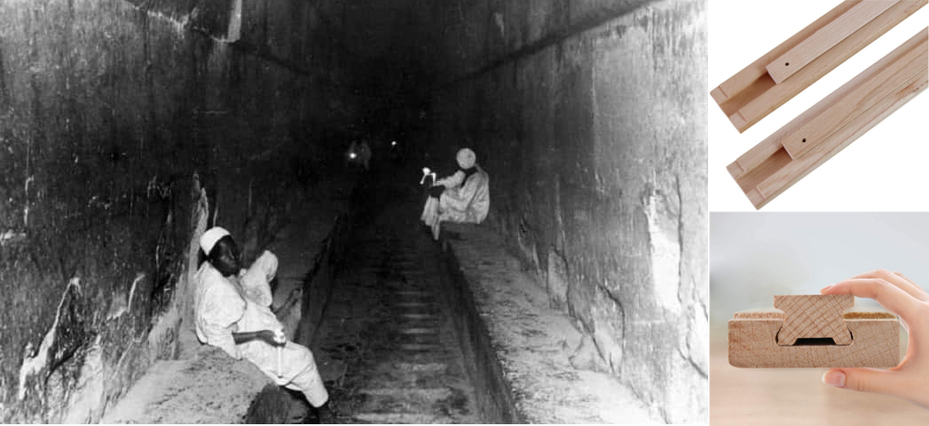
Wood Drawer Slide at https://www.amazon.ca/PCS-Inches-Wood-Drawer-Slide/dp/B087CJF7V9
32.40 The tracks of the Grand Gallery
The sledge runners of the impactor would have needed to be operated inside wooden tracks on each side of the central gutter (on both sides of the mysterious horizontal lines), and they would have most certainly looked like wood drawer slides.

Photographs thanks to kairoinfo4u. Anubis: https://www.flickr.com/photos/manna4u/33781706141/in/photostream/
Wadi Hammamat, Dynasty 11, Nebhepetre Mentuhotep II.: https://www.flickr.com/photos/manna4u/25932728632/in/photostream/
Wadi Hammamat, Dynasty 17: https://www.flickr.com/photos/manna4u/25999304796/in/photostream/
32.41 The projections of water behind Anubis' path
We've already seen in previous Sections that the flail was the ancient Egyptian way of representing projection of water, and that the direction of its end part points towards the direction in which the water is projected.
It is then not a surprise if Anubis is represented with the flail in so many occasions: the sledge was indeed projecting massive flumes of water behind its path. More about the flail in Section 3
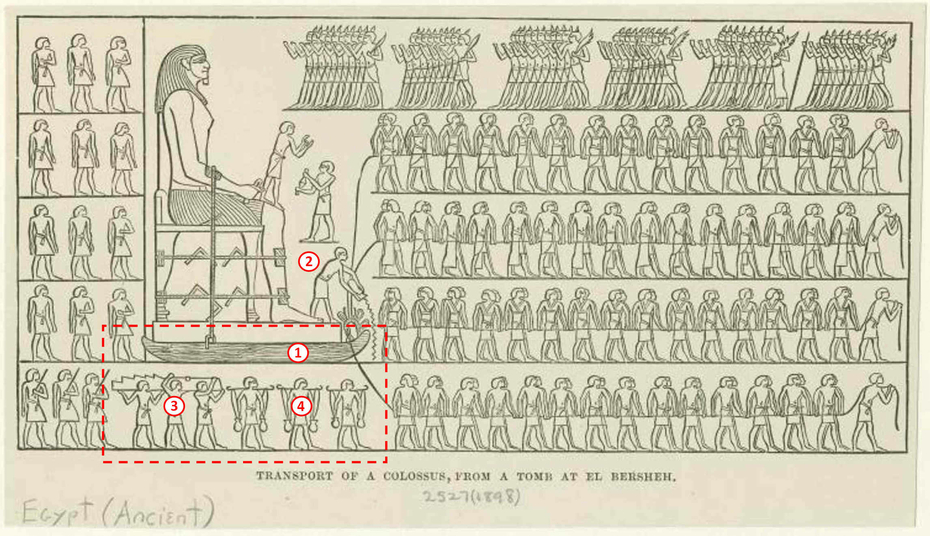
"Transport of a colossus, from a tomb at El Bersheh", at the New York Public Library: https://digitalcollections.nypl.org/items/510d47e4-37f4-a3d9-e040-e00a18064a99
32.42 The transport of the colossus of Djehutihotep
About the sledge, there is one more thing I want to address, and that is its use for the transport of the Colossus of Djehutihotep, because I must admit I feel very bad about the way Egyptologists are seeing the ancient Egyptians.
Even if the scene of the transport of the colossus is showing the combined use of a (very weird looking) beam and water, Egyptologists are seriously thinking ancient Egyptians were pouring that water directly onto the sand; just like they were 4 year old boys playing in the sandbox.
Seriously, don't you think they would have use tracks to guide the sledge?
Don't you think that this weird looking beam with notches is about the tracks? And don't you think they would have pour that water directly into these tracks?
If you look closely, you will notice that it is clearly indicated what should be put under the runners of the sledge, and what should come from the top of the runner: the strange notched beam and the water are supposed to be here, right underneath the sledge runners (and that really is sledge runners: ancient Egyptians didn't ever represented "flat" sledges, every single sledge came with runners); and at the same time they are also showing that the water was supposed to come from atop of the runner.
Maybe the "notches" are just like the latch bolts of the Grand Gallery, at least in their function if not in their design.
Anyway, the tracks on which the colossus was transported, functioned exactly like the ones in the Grand Gallery, with water used to reduce the friction, drastically.
" By far, Djehutihotep is known best for the famous decoration inside his tomb that represents the transport of a colossal statue of him that was nearly 6.8 metres (22.3 ft) high, being transported by 172 workers using ropes and a slide, in an effort that is facilitated by pouring water in front of the slide. With an estimated weight of 58 tonnes (57.1 long tons; 63.9 short tons), it was carved by a scribe, Sipa son of Hennakhtankh. Unfortunately, no traces of this colossus have ever been found. The colossus' depiction itself was irremediably vandalized and destroyed in 1890, and all the existing drawings are based on a single photo taken the previous year by a certain Major Brown. It is assume a rate of 5% of water ease the transport by up to around 30%." https://en.wikipedia.org/wiki/Djehutihotep
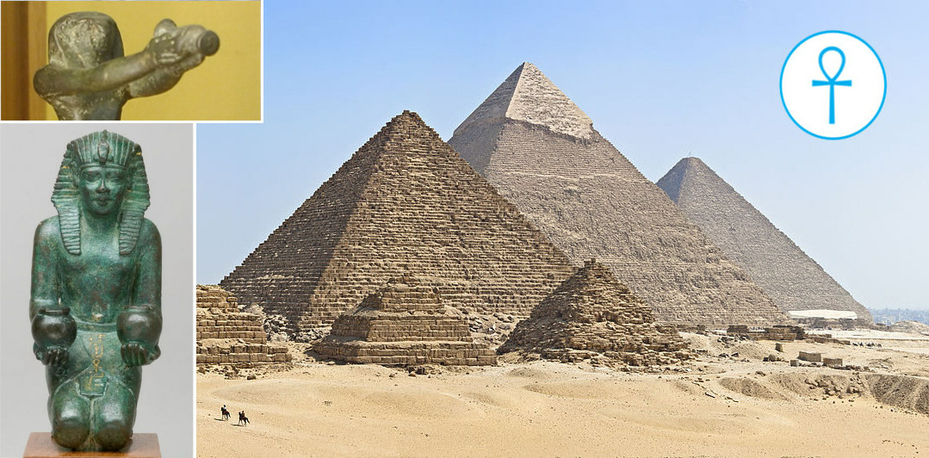
Horus holding the fog nozzle of the Great Pyramid of Giza, refreshing himself, and King Amasis demonstrating that he was able to master the Solvay process and that the manufacturing of sodium carbonate and sodium bicarbonate was successful. Horus Figure DUT 162 from the Louvre Museum and Kneeling statuette of King Amasis from the Metropolitan Museum of Art, New-York. Accession Number: 35.9.3 : https://www.metmuseum.org/art/collection/search/544886
Pyramids of the Giza Necropolis by KennyOMG : https://en.wikipedia.org/wiki/Giza_pyramid_complex#/media/File:Pyramids_of_the_Giza_Necropolis.jpg
32.43 Summary of the study: hidden behind the academic vision of the ancient Egyptian religion, a vast number of metaphors are describing some of the most advanced science and technological knowledge of that time : ancient Egyptian gods were nothing else than pharaohs' metaphoric self-glorifications of their theoretical and experimental scientific accomplishments in physics and chemistry.
Pharaohs used the power of Science to legitimate themselves as kings of Egypt : they forged an entire religion, based on science to rule their kingdom, and they presented that science as Magic.
The end game of this technological program that probably started on the very first Dynasty, was the Great Pyramid of Giza where evaporative cooling was engineered in the known part of the pyramid from the pressurized water produced in the inclined well, known today as the ascending passage.
The evaporative cold simply took advantage of the power of water, and was most probably necessary to cool down chemical manufacturing of sodium carbonate and sodium bicarbonate produced by an ammonia-soda Solvay process, as suggested by the very strong ammonia smell and the limestone kiln in the so-called burial chamber of the Red Pyramid. At that time, sodium carbonate was called natron, and it was the salt used for the mummification of the pharaohs (Sections 14, 15 and 16).
The cooling seems to have represented the most difficult part of the process, as suggested by the Step Pyramid's official name : according to scholars, the very first pyramid complex, the Step Pyramid of Djoser, was called "the refreshment of the Gods". No doubt that a more accurate translation would certainly be "the cooling of the Gods".
It means that ancient Egyptians were the first civilization to master a Solvay-like process for sodium carbonate manufacturing, long before it got reinvented in the 1800's in Europe. The key elements of that process is the temperature control of the chemical reactions (the cooling), and the dome shaped plate necessary for the counterflow chemical reactions to occur in an efficient way. That counterflow reaction plate is what really is the disc of Sabu.
As shown with Akhenaten and Nefertiti, the creation of the evaporative cold was the most sacred accomplishment of all (Section 17), and this is exactly what the Dendera Light is all about : the Dendera Light is the fog of microdroplets of liquid water that evaporates and creates the cold. Talking about the snake inside the Dendera Light Bulb : "The field surrounding Ra’s snake form is referred to in ancient Egyptian literature as protective magical energy in liquid form that all gods and pharaohs possess" (Faulkner, Section 2).
Everything that had been done in the Great Pyramid of Giza inspired most of the ancient Egyptian religion, and it had been glorified into what we know today as the Underworld.
The Underworld is referring to the chambers and passages of the Great Pyramid of Khufu, and in particular to the Grand Gallery where a hauling gantry beetle operated a wooden coffin shaped impactor that had a small nested granite block inside it. The impactor generated endlessly, over and over, maybe every 15 minutes the pressurized water that was then transformed into a fog of microdroplets inside the horizontal cooling passage.
The Grand Gallery of the Great Pyramid where the act of hauling was done, is the "Secret Hauling Cavern of the Underworld" described in the Amduat "Book of the Hidden Chamber".
The most important chamber of the Great Pyramid wasn't the King's chamber that only was the main water tank of the pyramid, but the Queen's chamber, the only one on the central axis of the pyramid. Because the Queen's chamber was inaccessible from the rest of the pyramid, it was glorified into the "Hidden Chamber of the Underworld" (Section 11), and because the Queen's chamber was the coolest place in the pyramid (about 5°C / 41°F), and with a constant 100% Humidity rate, this chamber was the one where the biggest amount of very hard salt encrustation had been documented by the first explorers of the pyramid in the 1800's and before it had been removed in 1998 by Zahi Hawass (Section 1). Very hard salt encrustation is the signature of the evaporative cooling process, even nowadays.
The most incredible thing is that pretty much everything I've just said, actually appears in many myths, and they don't even originate from ancient Egypt : the "Churning of the Ocean" Hindu myth that produces the immortal nectar Amrita, the Tibetan Prayer Wheels operated to give small amounts of 'merit' to too lazy Naga snakes, and the entire Norse mythology with Thor's magical hammer endlessly fighting another Great Serpent of the Underworld and producing a mist of cold from a mysterious well that would be opposed to hellishly hot heat waves.
I'm talking a lot about the impactor of the Great Pyramid, but it is nothing compared to the tremendous impact caused by what the ancient Egyptians had accomplished within the 78 years of the Great Pyramids Era, from Djoser to the Great Pyramid: the entire ancient World had been shaken up in their deepest beliefs beyond all comprehension; and we are still talking about it today.
Poster un commentaire
